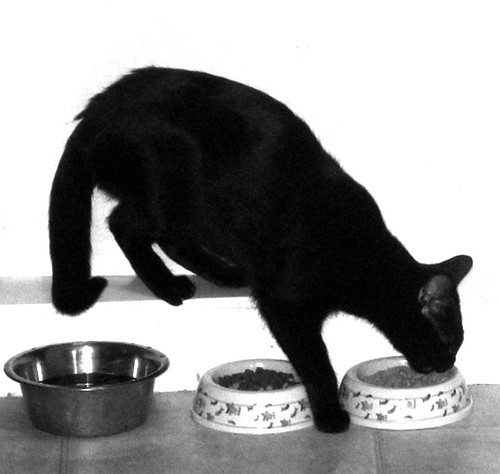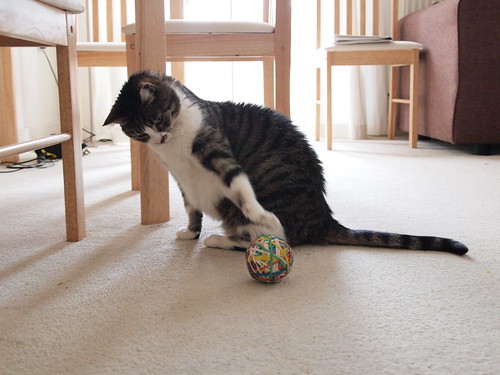 |
| Photo by Cuba Gallery (Click to see original on Flickr) |
 |
| Photo by Matt Ducke (Click to see original on Flickr) |
In the wild, cats eat 10-20 small meals over a 24 hour period. Therefore, feeding multiple small meals throughout the day is more consistent with natural feeding habits. While leaving dry food out all day ,ay make this easier, most wet foods tend to be lower in carbohydrates and higher in protein which can help with maintaining lean body weight. In addition, there are many ways to encourage your cat to hunt for their food such as food balls or food pyramids. It is also best to provide at least one bowl per cat in the home to prevent any competition, and place food bowls in a quiet or elevated area so that they may feel safe.
 |
| Photo by Amy Shojai (Click to see original on Flickr) |
Litter boxes should be placed in different locations throughout the house, and be in places where your cat will feel safe. They should be cleaned at least once daily, and washed with soap and water once a week. As a general rule, you should have one litter box per cat in the home, plus one. Large, uncovered boxes are usually preferred, however some cats prefer covered boxes. There are many different types of litter available, and it is best to alow your cat to choose by providing as assortment of litters, and ultimately selecting the one that he/she likes
 |
| Photo by Angus (Click to see original on Flickr) |
Scratching is a natural behavior for cats to both sharpen their claws and to mark their territory. Cat scratchers should be placed in your cats favorite areas of the house. Most pets prefer vertical to horizontal scratchers, but try both and entice your cat by placing cat nip, toys or treats on it. Never yell or punish your cat when scratching furniture, but instead use double sided tape to defer him from that location. In addition, praise your cat when he/she uses the scratcher.
 |
| Photo by Jasar Creative (Click to see original on Flickr) |
High places, such as perches are very important to their natural behavior because cats like to climb and prefer high places. It allows them to feel safe, and watch from above. One perch per cat is ideal, and should be placed in your cats favorite places, preferably near a window.
 |
| Photo by Adam Russell (Click to see original on Flickr) |
This is also an extremely important factor in an indoor only cat’s life. Mental stimulation can be provided by window seats near a bird feeder, or a variety of cat toys (laser light to simulate bugs, toys tied to a string to simulate rodents). Be sure to rotate toys, and put them away after playing to prevent a loss on interest.
 |
| Photo by Niklas Pivic (Click to see original on Flickr) |
Spending time every day brushing, petting, or playing with your cat is one of the most important aspects of environmental enrichment for your cat. At least 15 minutes per day is encouraged.
Written by Dr. Suzanne Brough, DVM
Read more or contact Dr. Suzanne:
Suzanne Brough, DVM
Lap of Love Veterinary Hospice
Naples Florida
drsuzanne@lapoflove.com |drsuzanne@lapoflove.com www.lapoflove.com
Dr. Bansel services towns in and around Collier and Lee counties including: Naples, Estero, Bonita Springs, Ft Myers, and Port Charlotte.







